| File:Quel'Thalas large 2.jpg | |
| Capital(s) |
|
| Races |
|
| Government | Interregnum (ostensibly); Hereditary monarchy (formerly)[1] |
| Ruler(s) |
|
| Major settlements |
|
| Minor settlements |
|
| Affiliation |
Horde Formerly: Independent, Alliance of Lordaeron |
- "... an entire land where magic is so much a part of the culture. Not just a part of the city, or confined to a handful of elite, educated magi. Magic is the birthright of every citizen. We are all embraced by the Sunwell."
- — Prince Kael'thas Sunstrider
Quel'Thalas [ˈkwɛlθɑˌlɑːs] (Thalassian for "High Home")[2] is a forested kingdom to the north of Lordaeron. It is ruled by the blood elves, descendants of the kingdom's Highborne founders, and is known as the Land of Eternal Spring.[3] Its capital is Silvermoon City.
Following their exile from Darnassian society and their abandonment of the Tirisfal Glades, the Highborne under the leadership of Dath'Remar Sunstrider founded the kingdom of Quel'Thalas to the north, within which they reinvented themselves as the high elves. Soon, Quel'Thalas became a shining monument to high elven prowess; the land was magically bathed in an eternal springtime, and Dath'Remar created the Sunwell, his people's own version of the Well of Eternity, which empowered the citizens of Quel'Thalas from then onwards. The elves earned the enmity of the forest trolls of Zul'Aman, under the Amani Empire, who viewed the elves as usurpers. After several long-spanning conflicts, King Anasterian Sunstrider presided over the Troll Wars, which dealt the Amani a defeat they would never truly recover from. In its seclusion, Quel'Thalas continued to prosper with the protection of the Sunwell (even rendering the invasion of the Amani remnants and their Old Horde allies fruitless), until the kingdom's formidable defenses were bypassed by the treacherous scion of Lordaeron, Prince Arthas Menethil, and his undead Scourge.[4]
During the Scourge invasion of Quel'Thalas, the high elves were nearly scoured from Azeroth: the king perished before Arthas's dark powers, the Sunwell was destroyed, and the bulk of their people were slaughtered. In the wake of this devastation, the king's son Prince Kael'thas Sunstrider proclaimed the surviving high elves reborn from the ashes of their shattered kingdom and people, as the blood elves.[5] The blood elves worked tirelessly to reclaim their homeland from the lingering undead, and would eventually succeed in taking back much of their country, the capital of Silvermoon included. In a dramatic turn of events, a twisted Prince Kael'thas returned to beauteous Quel'Thalas and attempted to summon the Burning Legion via the Sunwell. The prince's dark ambitions were not to be realized, however, and the Sunwell itself would ultimately be returned to the blood elves by the Prophet Velen. With the Sunwell restored, a bright future now lies ahead for Quel'Thalas.[5]
The kingdom of Quel'Thalas is currently led by its regent, Lor'themar Theron, following the fall of the royal family. It serves as the starting location for the Horde-aligned blood elves in the Burning Crusade expansion, and consists of three zones: Eversong Woods, the Ghostlands, and the Isle of Quel'Danas.
History

Map of Quel'Thalas.
New beginnings
Banished from Kalimdor by their night elf brethren, the Highborne led by Dath'Remar Sunstrider left their ancestral homeland behind them and struck out across the Great Sea in search of whatever lands might lie beyond the Maelstrom. Their determination was rewarded when they discovered the continent that would eventually become known as the Eastern Kingdoms, landing in a region filled with lush woodlands and wildlife. The Highborne traveled on foot for months until settling in a region known to its primitive human residents as Tirisfal. The Highborne initially had little interaction with the humans, but gleaned from them the legend of Tyr, a guardian who had sacrificed himself to slay a mighty foe in Tirisfal. Indeed, the Highborne had noticed powerful energies in the land—energies the primitive humans could not detect. It could not match their old Well of Eternity, but it intrigued the arcane-practitioning elves nonetheless. They believed they could regain their lost glory if they unlocked its secrets, but in time this proved unfeasible; the energy was dark and corrupted, and drove the elves who dabbled in it mad. Furthermore, cut off from the Well, the Highborne became susceptible to mortality, age and disease. Their skin had lost its violet hue, and they had shrunk in stature. The Highborne feared these effects would only worsen over time.
The Highborne grew increasingly expedient, convinced that the humans had built their settlements over the most potent ley lines. Some pushed for war, resolved to outright conquer the native humans or at least force them to relocate. Dath'Remar Sunstrider did not agree. The Highborne leader saw no wisdom in making enemies of beings that posed his people no threat. He had also noticed the dark energies radiating from the land, and theorized that it was responsible for the sudden rise of belligerence and madness afflicting his kind. Ultimately, he chose to lead them away from Tirisfal to avert violence and spare them from a potential calamity. He decided that they would make a new home in the north. There, Dath'Remar's scouts had discovered a region rife with lush forests and powerful ley energies. Intent on reaching this land, the beleaguered Highborne left Tirisfal and marched north into the unknown.
The founding of Quel'Thalas

The forests of Quel'Thalas as depicted on the official website. See Ghostlands for a modern depiction of the less fortunate south.
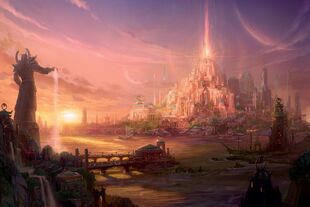
The kingdom of Quel'Thalas after its founding.
Dath'Remar and the Highborne continued their quest to find a home on the Eastern Kingdoms. Following the trails of magical essence, they traveled north through perilous weather; a deadly blizzard trapped the elves for nearly a month as they pressed on. For the first time in living memory, the Highborne began to die of starvation; only the compassion of primitive humans living in the mountain kept the entire expedition from perishing. The lesson was a harsh reminder of all they had lost, cut off from the Well of Eternity. Once the storm lifted, they forged ahead, shaken but determined to find their new home. Hope warmed their weary hearts when they finally reached the land Dath'Remar's scouts had spoken of: verdant woodlands covered the terrain, and the very ground beneath the Highborne's feet crackled with potent lines of magic. But the elves soon discovered that another race also called this region home: the barbaric Amani forest trolls.
The arrival of the Highborne infuriated the Amani trolls, who harbored a bitter hatred of elves from the days of Queen Azshara. The Amani sent out raiding parties immediately to slaughter the unwanted trespassers, and the Highborne soon learned to fear troll ambushes in the dense forests. Yet the elves were stubborn, and pushed forward, using their great magical prowess to decimate any Amani who dared to cross their path. As the elves had feared the trolls, the trolls learned to fear the elves. The constant skirmishes fostered a mutual, bitter enmity between the Amani and the Highborne. Despite the trolls' ferocity, the elves finally reached the nexus of ley lines they had been seeking. Powerful torrents of arcane energy converged in the vibrant forests. Dath'Remar proclaimed that this was where his people would begin their civilization anew.
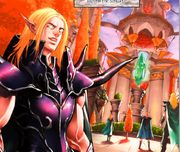
Dath'Remar Sunstrider, first king of Quel'Thalas, in Silvermoon City.
Dath'Remar shocked his followers by revealing a vial containing energy from the Well of Eternity, one of several created by Illidan Stormrage, that the Highborne leader had stolen from the night elves' custody shortly before their banishment from Hyjal. Dath'Remar poured the vial's enchanted water into a small lake at the center of the nexus, and a brilliant fount of energy tore through the skies of Azeroth. The Highborne dubbed this glorious cradle of power the "Sunwell," a name chosen in honor of Dath'Remar and his bold quest to reignite their culture.
Thereafter, the Highborne abandoned their worship of the moon, instead taking strength from the sun. In time, they took the name "high elves," and the arcane power available to them increased by an astonishing degree. Although the journey had been torturous, Dath'Remar had led them to salvation. They called their new land Quel'Thalas, ("High Home"), and declared that it would dwarf the night elves' civilization and stand as a monument to the ages.[6]
The Amani did not agree. The high elves had built their new kingdom—a kingdom centered on the Sunwell, the heart of their new culture—atop ancient Amani ruins, ruins still considered hallowed ground by the trolls. Outnumbering the elves nearly ten-to-one, the Amani struggled ferociously to drive the invaders from their sacred land. The high elves drew on the full might of the newfound power the Sunwell afforded them, but could barely hold off the trolls' assault. Dath'Remar himself led almost every battle against the fierce Amani. Bit by bit, the elves carved out the borders of their kingdom, securing a new home, paid for in the blood of their brothers and sisters.
Yet many of the high elves grew wary of their rampant use of arcane magic, fearing that it could once more draw the Burning Legion to Azeroth. Dath'Remar sent his most powerful arcanists to find a solution. Over several decades, they built a series of monolithic runestones around Quel'Thalas' borders. This barrier was called Ban'dinoriel, or "the Gatekeeper" in the high elven tongue. It would prevent others from detecting the high elves' use of magic, ward off the superstitious Amani, and weaken the magic of all non-elves within it.[3] The trolls eventually retreated into their temple city of Zul'Aman. They decided it was safer to ambush elven convoys that strayed beyond the magic barrier than to launch a full assault on Quel'Thalas. An elite group of rangers soon arose to combat this threat.

Silvermoon City, the capital of Quel'Thalas.
Within the borders of Quel'Thalas, civilization thrived. No longer fearful of using magic, the high elves created marvelous works that bathed their kingdom in eternal springtime. Never again would they experience another winter as brutal as the one they had suffered en route to this cherished land. Their capital, Silvermoon City, became a shining monument to the memory of the elves' ancient empire. Silvermoon was constructed out of radiant white stone and adorned in crimson tapestry.[7] With his new empire established, Dath'Remar stepped down as leader. His bloodline would go on to inherit a magical kingdom of peace and prosperity. Its beauteous palaces, crafted in the same architectural style as the ancient halls of Kalimdor, were interwoven with the natural topography of the land. Quel'Thalas had become the shining jewel that the elves had longed to create. The Convocation of Silvermoon was founded as the ruling power over Quel'Thalas, though the Sunstrider Dynasty maintained a modicum of political power. Comprised of seven of the greatest high elf lords, the Convocation worked to secure the safety of the elven lands and people, and Quel'Thalas prospered in peace. Yet this era would come to an end when Dath'Remar's great-grandson, Anasterian Sunstrider, donned the mantle of leadership. He came into power at a time when his people faced war with the trolls once again.
The Troll Wars
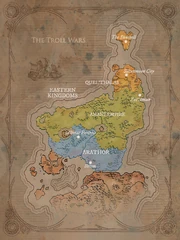
Quel'Thalas, Arathor, and the Amani Empire during the Troll Wars.
Millennia after their defeat at the elves' hands, the Amani trolls plotted revenge within Zul'Aman. Though they were fierce warriors and possessed savage voodoo magic, they lacked unity and a strong leader. Infighting had also spread throughout the tribe, threatening to destroy it from within. Their fortune changed when they received aid from the revered Zandalar tribe. The Zandalari saw themselves as the protectors and spiritual leaders of all trolls, and sought to strengthen troll societies all across Azeroth. The trolls had languished since the Great Sundering, the Zandalari included. In the Amani, the Zandalari saw an opportunity to revitalize one of their race's most powerful tribes and reassert dominance on the Eastern Kingdoms. Overwhelming the high elves would be no easy task, but despite its founder's claims, Quel'Thalas was not as powerful as the ancient night elf empire that had decimated the trolls so long ago.
The Zandalari formed an alliance with the Amani, and marshaled their forces for the impending conquest. The Zandalari would ensure that the mighty loa demigods would aid the trolls in battle. To settle the matter of leadership, the Zandalari made one of the Amani's fiercest warriors, Jintha, the ruler of his people. Small Amani warbands ventured from Zul'Aman to raid the high elves and test their strength.The cunning trolls hid their true numbers and capabilities; and after several successful attacks, decided that the time for all-out war had finally come. Without warning, tens of thousands of troll fighters exploded from the shadowy forests. Fearsome loa demigods marched alongside the Amani, infusing their adherents with supernatural power. The high elves struggled desperately to hold back the trolls, but were forced to give ground. With astonishing speed, the Amani laid waste to the outer reaches of Quel'Thalas. The Zandalari emissaries were pleased by what they saw: even the elves and their potent arcane powers could not withstand the might of the Amani—the might of the troll race.
The expanding troll empire was not a threat only the elves were faced with. King Thoradin of Strom had also feared how far the Amani's ambitions would reach, and kept a careful eye on the intensifying war between the high elves and the Amani. Although he heard of much death and destruction in the elven homeland, he remained stubborn in his belief that intervening would put his own people at unnecessary risk. His opinion finally changed when high elf ambassadors sent by Anasterian told the king firsthand of the Amani's stark brutality and the demigods walking the land; surely, Strom would be next if Quel'Thalas were to fall. Convening with his advisors, the king agreed to form an alliance with the elves, but even so he doubted they had the power to destroy the Amani. They issued the elves an ultimatum: in return for Strom's military aid, the humans would be taught in the ways of magic. Elven magic was legendary among humans, but even Thoradin, deeply suspicious of sorcery, knew the humans needed it to win the battle.
Anasterian knew well the dangers of unchecked magic. He knew that teaching the arcane arts to humans could easily lead to disaster. Yet, as much as this troubled Anasterian, his own people were facing extinction. Knowing he had little choice, he agreed that one hundred—and only one hundred—humans would be tutored in the rudimentary ways of magic. Elven magi traveled to Strom and began their mentorship; over the course of many months, the elves were stunned at the natural affinity the humans had for magic, even if they lacked in grace and subtlety.
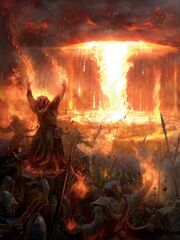
Human magi unleashing their powers on the Amani trolls.
Once the elves had finished tutoring the human magi, Arathor launched its offensive. Over twenty thousand human soldiers gathered at Alterac, and Thoradin himself led his armies to Quel'Thalas. The full might of Arathor's armies smashed into the Amani's rear flank, while the high elves began a heavy assault in the north and laid waste to the trolls' front lines. Though faced with enemies of both sides, Jintha remained confident in the Amani's victory, resolving to crush Arathor first and return to purge the elves from Quel'Thalas for good. Thoradin called for a retreat, and lured the voracious Amani into a deathtrap in the mountains of Alterac, whittling the trolls' numbers down on both fronts. The final battle took place outside of Quel'Thalas, and the Amani, stuck between the elves to the north and the humans to the south, took massive losses when the human magi (whose existence had been hidden), were revealed and unleashed. Alongside the elven sorcerers, the humans called upon their vast new powers. The humans pooled their energy together and wove a single terrible spell, engulfing the Amani ranks in a searing conflagration. Loa and troll alike fell and burned.
Jintha was among the first to fall. Leaderless, the Amani broke ranks and retreated north, but were hunted down and slaughtered at every turn. The disastrous battle shocked the Zandalari emissaries, who fled back to their island in shame and disbelief. For them, this defeat marked a dark turning point in history. Yet for Quel'Thalas, the war was the beginning of a glorious new era. For months after the conflict's end, celebrations graced the streets of Silvermoon. The grateful elves pledged their loyalty to Arathor and Thoradin's descendants.[8]
Beyond the borders
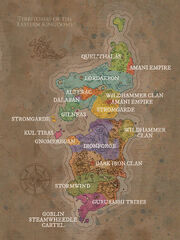
The territories of the Eastern Kingdoms prior to the First War.
Years passed, and Quel'Thalas continued its prosperous growth. When the kingdom of Dalaran was founded to the south, some of the elves traveled there to teach, study, and reside, including Quel'Thalas's own crown prince, Kael'thas Sunstrider, and future Grand Magister, Rommath. Silvermoon and Dalaran established an alliance that would continue for over 2,000 years to come.[9] Indeed, many of the Magisters of Quel'Thalas would study in Dalaran together with the Kirin Tor.[10]
At some point, the grandfather of King Terenas Menethil II successfully negotiated with Quel'Thalas to formally establish the border between the elven kingdom and Lordaeron.[11]
The Second War

Territories of the Horde and the Alliance during the Second War.
Nearly three thousand years later, shortly after the fall of the Kingdom of Azeroth, Anduin Lothar - the last blood descendant of King Thoradin - led his people across the Great Sea to Lordaeron, where he went before King Terenas and warned of the coming of the Orcish Horde. Terenas immediately called a council of the neighboring kings which led to the formation of the Alliance of Lordaeron. With Lothar named Supreme Commander, Terenas sent a missive to King Anasterian Sunstrider - himself a veteran of the Troll Wars millennia before - informing him of Lothar's lineage and the request for aid to the Alliance. At first, Anasterian reluctantly sent a token display of support in the form of a party led by Alleria Windrunner. The king himself was hesitant to fully involve Quel'Thalas in the war, and had hoped to remain impartial should the orcs not threaten his own kingdom.[3]
Not long afterwards, when Orgrim Doomhammer led the Horde's invasion of Quel'Thalas and began burning the edges of the Eversong Woods, it was discovered that the Horde was being aided by the elves' mortal enemies, the Amani, led by the cunning Zul'jin. The orcish necromancers had succeeding in subverting some of the runestones, allowing their magic free reign and their forces to approach the capital, though the invaders could not pierce Ban'dinoriel even with their red dragon servants. Alleria brought the head of a freshly slain troll warrior to the Convocation of Silvermoon, throwing it at Anasterian's feet. This provoked an intense rage within the King of Quel'Thalas, and he immediately called for the mobilization of his armies to battle the Horde. The elves provided many archers, rangers and destroyers to the conflict, and even craftsmen for the lumber mills of the Alliance. The effort was led by Sylvanas Windrunner, Ranger-General of Silvermoon. Making little progress, the orcs soon abandoned the battle in favour of besieging Lordaeron, and the Alliance forces pursued them. The Amani saw the orcs' withdrawal as a betrayal and chose instead to fight a hopeless, vicious battle in Quel'Thalas, only to be beaten back after considerable bloodshed.[12] Zul'jin himself was captured by the elven ranger Halduron Brightwing and his platoon, though narrowly escaped and went into hiding.
Quel'Thalas was, at best, a reluctant member of the Alliance.[13] In the wake of the Second War, humanity began to distance itself from Quel'Thalas,[14] and in turn the high elves came to view the deteriorating Alliance with increasing coldness.[14] King Anasterian himself felt betrayed by the Alliance's retreat to Lordaeron during the war, which left the elves to deal with the rampaging Amani trolls alone. Anasterian claimed that the Alliance had abandoned Quel'Thalas in its darkest hour, and while not all of the high elves agreed with him, enough did.[12] The tension eventually came to head when King Anasterian withdrew his support from the Alliance entirely. The official stance was that the humans' poor leadership resulted in the burning of Eversong Woods (even though Terenas reminded him of the many humans who gave their lives to protect Quel'Thalas); in addition, with Lothar dead and the Horde defeated, Anasterian believed that the debt to Thoradin and his descendants was repaid. With few exceptions - including some elven priests and sorceresses, as well as Anasterian's son and heir, Prince Kael'thas, a member of the Kirin Tor of Dalaran - the majority of the elven race shut themselves inside their enchanted kingdom.
Anasterian's decision to secede was the catalyst that led to both King Genn Greymane and the nation of Stromgarde to follow the high elven king's example, a domino effect that would soon have dire repercussions for the humans and elves alike.[4]
The fall of Quel'Thalas

Arthas Menethil leads the Scourge invasion of Quel'Thalas.
- Main article: The Scourge invasion of Quel'Thalas
Almost fifteen years later, the Plague of Undeath broke out in Lordaeron. Terenas' son Arthas, a paladin trained by Uther the Lightbringer himself, made efforts to stop the Plague from turning his beloved people into mindless undead raised to serve the Lich King, master of the Scourge. Instead, the whole chain of events appears to have been engineered by the Lich King himself to find a suitable host for his bodiless mind, and Arthas fell into despair and eventually madness. Travelling to Northrend, he forfeited his soul to the Lich King upon taking up the runeblade Frostmourne.
Now the greatest of the Lich King's death knights, Arthas traveled back to his homeland, murdered his father and all but obliterated the Kingdom of Lordaeron. Afterwards, he was tasked by Tichondrius, the leader of the Dreadlords and the Lich King's chief jailor, to resurrect the necromancer Kel'Thuzad - whom Arthas had killed not long before - so he could fulfill his appointed duty of summoning Archimonde into Azeroth. Tichondrius also told Arthas that there was only one suitable place to resurrect Kel'Thuzad - the mystic Sunwell, the source of the high elves' magic, deep inside Quel'Thalas.

The entrance to Quel'Thalas, named the Thalassian Pass, ravaged by the Scourge during their attack.
To reach the Sunwell, Arthas needed an insider, someone who could allow him to bypass the magical defenses of Quel'Thalas; he found one in Dar'Khan Drathir, a disillusioned magister. Dar'Khan, an egotistical and embittered man, believed he deserved more than he was receiving. Arthas preyed upon his ego, promising Dar'Khan untold power in exchange for his aid, and his loyalty. With the backing of his "Blessed Lord Arthas", Dar'Khan provided the Scourge with two powerful artifacts - the Stone of Light and the Stone of Flame - that had warding powers against the undead, allowing the Scourge armies to circumvent Quel'Thalas' formidable defenses. Thus, Arthas led the Scourge in a march of death up a path that today is known as the Dead Scar, across the Elrendar River into Eversong Woods, destroying one of the protective runestones on the edges of the forest.
The elves, in an attempt to stop the blight from spreading further into Eversong Woods, set the area around the destroyed runestone to the torch. But the armies of the Scourge pressed on, breaking through the Elfgates and through Silvermoon itself. Ranger General Sylvanas Windrunner led the defense as best she could, but she fell to the power of Frostmourne. In a cruel gesture of dominance, Arthas took Sylvanas' lifeless body and ripped her spirit from it, creating the first banshee. Even the blade Quel'Delar, King Anasterian, Grand Magister Belo'vir, and the Convocation of Silvermoon were no match for Arthas and his legions, slaughtered with their people by the relentless tide of the mindless undead.
With Silvermoon in ruins and the elves broken and scattered, Arthas fulfilled his task and submerged the corpse of Kel'Thuzad within the waters of the Sunwell, fouling the potent waters of Eternity; the necromancer returned to the world of the living as a sorcerous lich.
When word of Quel'Thalas' fall reached Dalaran, Prince Kael'thas - now the last of his bloodline and de jure leader of the high elves - returned to his homeland, joined up with Lor'themar Theron and the survivors, and destroyed the now-tainted Sunwell to prevent a further catastrophe. Kael proclaimed the high elves reborn as the blood elves, in honor of their perished brethren.
Reformations
The Scourge invasion hugely changed the political scene of Quel'Thalas. With the deaths of roughly 90% of the kingdom's population (including its king, ranger-general, grand magister, and ruling council), many political decisions were made to fill the voids left.
- Kael'thas Sunstrider assumed his role as the rightful ruler of Quel'Thalas, succeeding his father, Anasterian Sunstrider. He chose not to crown himself, instead honoring his father posthumously as the last high elven king, and styling himself with various other titles (prince, lord, “Sun King,” etc.) thereafter.
- Lor'themar Theron, former second-in-command to Sylvanas Windrunner, was named the regent lord of Quel'Thalas, to safeguard the kingdom in Kael's absence.
- Halduron Brightwing, a close friend and comrade of Theron, was elected as the new Ranger-general of Silvermoon, leader of the Farstriders, and general Thalassian military leader, replacing the fallen Sylvanas Windrunner.
- The archmage Rommath was made the new Grand Magister of Quel'Thalas, replacing previous grand magister Belo'vir Salonar.
- The Convocation of Silvermoon, wiped out completely by Arthas and Dar'Khan, was never restored. Kael instead became the sole ruler of the blood elves.
Betrayals and second chances
The elves rejoined the Alliance armies, where they called themselves blood elves in honor of their fallen. But the Alliance began to look down on their elven "comrades". The ethnocentric Grand Marshal Garithos, the leader of the Alliance remnant, often gave the blood elves tasks that either beneath their capabilities as warriors or - worse - suicidal. Kael'thas was forced to call upon the aid of the night elves (led by Malfurion Stormrage and Tyrande Whisperwind, hunting for Malfurion's brother Illidan) and, later, Lady Vashj and the naga.
When Garithos discovered the naga had aided Kael and his brethren, he sentenced them to death for treason. Kael and his comrades were rescued by Vashj and her naga, who took them to Illidan in the wastes of Outland. With the promise of as much magic as they required, Kael'thas pledged the loyalty of the blood elves to Illidan's cause. Settling in Outland with the rest of Illidan's forces, Kael'thas sent a magister named Rommath back to Quel'Thalas, with the promise that Kael'thas would one day return to lead the blood elves to paradise. Rommath rejoined Lor'themar Theron, Regent Lord of Quel'Thalas, and informed him of Kael'thas' command to prepare the blood elves for their journey into the "promised land" beyond the Dark Portal. Rommath also brought back teachings the prince had learned from Illidan - the ability to siphon arcane magic from external sources, be it objects or creatures or humanoids. This proved invaluable to the beleaguered elves, most of whom were suffering from arcane withdrawal with the Sunwell's constant flow of energy gone, and lacking the strength to restore their beloved homeland. Rommath and the magi used their powerful magics to reclaim and rebuild the western half of Silvermoon City almost overnight, and the blood elves struck out to reclaim Eversong and push into the scoured south.[3]
Kael'thas also sent back M'uru to Quel'Thalas, a naaru guardian whom he had defeated in Tempest Keep. The blood elves learned to manipulate and harvest his holy energies, using them to empower a group of pseudo-paladins dubbed the Blood Knights.
Modern Quel'Thalas, high home of the elves.
Meanwhile, Dar'Khan Drathir had been killed by a group of blood elves, dragons and Sylvanas. Anveena's true identity was to be kept a closely-guarded secret by Quel'Thalas' leadership.
Following failed negotiations with the Alliance, the blood elves have turned to the Horde for support. The Forsaken, in particular, are staunch supporters of the blood elves' membership in the Horde, as their queen, Sylvanas Windrunner, was Ranger General during the Scourge invasion and a good number of Forsaken are high elves who were killed in the war. Only one major obstacle preventing their becoming full members of the Horde remains: the Scourge that remain on the footsteps of Quel'Thalas, marching from their citadel of Deatholme at the southern terminus of the Dead Scar. There, the resurrected Dar'Khan Drathir directs the Scourge in Quel'Thalas; only his death would allow the blood elves to become equal members of the Horde.
Quel'Thalas would later be shaken by the sudden betrayal of Kael'thas, who had switched his loyalties to that of the Burning Legion. In a mad bid to summon his new master Kil'jaeden from the Isle of Quel'Danas, Kael'thas attacked his homeland to steal M'uru, and the Shattered Sun Offensive was formed to end the Prince's dark ambitions. Lady Liadrin traveled to Shattrath City, and pledged the blades of her Blood Knights to fighting alongside the newly-formed offensive and reclaiming Quel'Thalas. In a conversation with A'dal, she learns that M'uru had known of his role long before the blood elves had ever taken him; that he had given himself willingly to the sin'dorei, knowing that his demise would pave way to a brighter future for both them and their home of Quel'Thalas.[15]
Shortly after the demise of Prince Kael'thas, Kil'jaeden was pushed back to the Twisting Nether and the Isle of Quel'Danas was reclaimed. The Blood Knight matriarch Lady Liadrin and the draenei Prophet Velen arrived at the site of the Sunwell, tainted by both the Scourge and Kil'jaeden. As Liadrin lamented the fall of Quel'Thalas and the levels its people had sunk to in order to reclaim it, the prophet restored the Sunwell in a blaze of light, noting that this would be the first step to rebirth the soul of the nation.[16]
Then and now
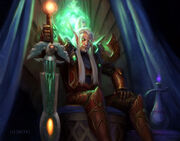
Lord Lor'themar Theron on his throne.
The past few years had seen unprecedented changes in the eternal realm of Quel'Thalas, from one near-calamity to another. With the restoration of the Sunwell, a bright future now lies ahead for Quel'Thalas.[5]
Reinvigorated, the blood elves fight to protect Quel'Thalas, conquer their magical addiction with the Sunwell's sustainment, and help redeem the soul of their ancient people.[17]
In the wake of Prince Kael'thas's betrayal, Lor'themar Theron has become the de facto leader of the country, continuing to style himself as its Regent Lord. With the Isle of Quel'Danas back under blood elf control, the Sunwell has been reinforced and open only to native visitations.[18] The remnants of the Sunfury forces have also returned home following the War in Outland, put to the task of defending Quel'Thalas's borders with the Farstriders.[1] Quel'Thalas was likely the first target for the new troll empire brewing in Zul'Aman. Ranger-general Halduron Brightwing joined forces with Darkspear Chieftain Vol'jin and Vereesa Windrunner to counter this threat.
Following the Purge of Dalaran, Archmage Aethas Sunreaver (and the escaped Sunreavers themselves) returned home to Quel'Thalas. In response, the Thalassian leadership moved to assemble their forces, noting that the time had come for the blood elves to take matters into their own hands.
Notable leaders
| History | Highborne exile | Kingdom of Quel'Thalas | Fall of Quel'Thalas | Rise of the Blood Elves | |||
|---|---|---|---|---|---|---|---|
| Ruler | Dath'Remar Sunstrider | Unknown | Anasterian Sunstrider | Kael'thas Sunstrider Lor'themar Theron |
Lor'themar Theron | ||
Quel'Thalas' regions
Zones in World of Warcraft
- Eversong Woods - Starting area for the blood elves (in the Burning Crusade).
- Ghostlands - Also known as the Blackened Woods (in the Burning Crusade).
- Isle of Quel'Danas, also known as the Sunwell Isle - location of the Sunwell; opened in Patch 2.4.0 (the RPG also states that it is the home of the dragonhawks of Quel'Danas).
Other regions
- Zul'Aman - Home of the Amani forest trolls (In WoW it's an instance within Ghostlands, instead of its own zone).
- Silvermoon - more of super region including, Silvermoon City all the way to Sunwell Grove(Quel'Danas).
- Blackened Woods - More of a super region including all areas south of the Silvermoon region (Eversong Woods and Ghostlands).
- Greenwood Pass (WC3).
World of Warcraft
Vanilla
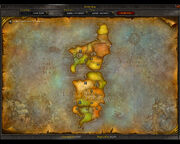
Location of Quel'Thalas in the Old World, swimming from Hinterlands.
- Main article: Quel'Thalas/Eastern Kingdoms terrain
There is also a zone of the "old world" officially named Quel'thalas. It was the only glimpse of Quel'Thalas before the Burning Crusade expansion, and was accessible in the game. See Northern Lordaeron and this subpage for more information and speculation about the zone. Adon the high elf hinted that the zone was to be added in a later add-on.
Prior to Patch 4.0.3, you could reach it by swimming along the coast from Tirisfal Glades east; or north from the Hinterlands beyond the coast of the Eastern Plaguelands.
Located near the peninsula of the unnamed zone is a tall white tower that is currently inaccessible that has a dock nearby.
Following the Cataclysm expansion and the ability to fly in Azeroth, invisible walls now prevent conventional access to the "old" Quel'Thalas.
Burning Crusade

Current Quel'Thalas map.
Quel'Thalas was opened in World of Warcraft: The Burning Crusade, and is split into three main regions. To the north is the Isle of Quel'Danas, home to the dragonhawks and location of the mystical Sunwell. South of Quel'Danas, across a channel of the North Sea, is Eversong Woods, the blood elf starting zone and the location of their capital, Silvermoon City. To the south of Eversong, across the Elrendar River, is the Ghostlands. It is here that the primary base of the Scourge in Quel'Thalas, the fortress of Deatholme, is located - as is the city of Zul'Aman, the capital of Quel'Thalas' long-hated enemies, the Amani forest trolls.
All of Quel'Thalas is bisected by a path of Blight known as the Dead Scar. This was the path taken by Arthas from Lordaeron to the Sunwell in his quest to resurrect Kel'Thuzad, running from Deatholme all the way through the Ghostlands and Eversong Woods, coming to a stop midway through Quel'Danas at the gates of the Sunwell Plateau. The path is patrolled by remnants of the Scourge invasion of Quel'Thalas. All attempts by blood elf magisters to cure the blighted soil have failed, giving the blood elves more of an incentive to seek out the destiny promised them beyond the Dark Portal.
Quel'Thalas is connected to the old world via the Thalassian Pass in southern Ghostlands, which goes along the main road (blocked by debris prior to Burning Crusade) into Lordaeron, in the region now called the Eastern Plaguelands. The path between Ghostlands and EPL is separated by an instance portal; the areas in which the "instance" falls under are all three regions of Quel'Thalas, both islands of the Azuremyst Isles (where the draenei start out) and all of Outland.
Wrath of the Lich King
Players will briefly visit the Sunwell during the quest to restore Quel'Delar.
Cataclysm
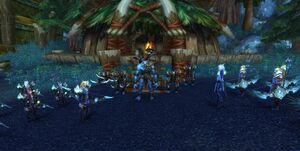
Halduron, Vol'jin, Vereesa and Lor'themar's courier meet on the outskirts of Zul'Aman.
While most of the rest of Azeroth has been updated and moved forward in the timeline to just after the Cataclysm, Quel'Thalas remains as it was in The Burning Crusade expansion. Specifically, the Scourge show no abatement as a result of Arthas' defeat; while the large, green crystals filled with fel energy, said to have been removed at this point in the timeline,[9] still dot the landscape in Eversong Woods and Silvermoon City. In the lore timeline, the blood elves should be using the now-restored Sunwell for power (although, their fel-green eyes will take a long time to wear off)[19] while the Scourge still has a presence in Ghostlands by the time of Invasion of Pandaria as encountered by Sylvanas Windrunner during the trial of Garrosh Hellscream.[20] Additionally, the Isle of Quel'Danas should now be free of Scourge, Burning Legion, and Kael's forces; this progress can only be glimpsed during the quest line for Quel'Delar in a phased version of the isle. It is unknown whether Quel'Thalas will be updated to the present time, and if so, when.
Discounting standard city updates (the addition of new class trainers and some updated Blood Knight quest text), the battle against the revitalized troll empire brewing in Zul'Aman marks the first major change to Quel'Thalas post-The Burning Crusade, as the Quel'Delar segment is phased for its entirety.
Sources
From "World of Warcraft: The Burning Crusade" in Computer Gaming World, December, 2005 by Jeff Green:
- The blood elf starting area is Sunstrider Isle -- many thought the Scourge has destroyed most of their land, this is still a vital, healthy area -- as you can see from the screens. "We wanted a look that was the opposite of the night elf look," says Metzen, "Where the night elves live in eternal twilight, we wanted the high elves, at their best, to live in a place of eternal spring and vibrancy. Arthas has destroyed most of it, but some of it still lives on." Blizzard also wanted a different architectural vibe for the blood elves' land. "The night elves have a somewhat Nordic and Japanese architecture," says Metzen. "We wanted something more classical and magical this time."
- At this point Quel'Thalas is set to be composed of roughly three to five zones, including Eversong Forest, the starting zone (and also the location of the blood elf capital, Silvermoon City), the Ghostlands, which border the Eastern Plaguelands to the south, and the Sunwell Plateau, which won't be part of the initial expansion but will be a part of a live update down the line. Blizzard is also adding a high-level instanced area, Zul'Aman, home of the forest trolls, as incentive for players to take their old characters up into this new land.
- One key goal for Blizzard was to make sure that, for this new Horde race, there was enough variety in the zones to keep things interesting. "We wanted to mix things up more this time," says Rob Pardo, VP of game design, "We learned from Kalimdor that there was just too much of the same thing--too much desert, too much bleakness."
- One particularly distinctive feature of this area will be that Metzen jokingly calls the "Road o' Death," the trail that Arthas' army marched through in WarCraft III, which completely bisects the land all the way through, including Silvermoon City. "It's a constant reminder to the blood elves," says Metzen, "of just how much shit these guys have gone through."
Notes
- The demonym for a citizen of Quel'Thalas is Thalassian, sometimes Quel'Thalassian.[21]
- It is hinted that the aqiri empire stretched as far as the lands that would much later be known as Quel'Thalas.[22]
- Snowing was possible in the southern border of the kingdom,[23][24] though it is possible that is is only possible after the fall of Quel'Thalas.
- The Darkspear tribe seems to have had a village here until burned by the Amani trolls.[25]
- The map published in the Warcraft II manual shows several regions including Khaz Modan, Quel'Thalas, and Lordaeron, each sharing the same font size. Azeroth is shown with a larger font size.[26]
- There is some inconsistency with Quel'Thalas' pre-Third War color scheme. Several sources that detail pre-Third War Quel'Thalas (including official art, the manga, and the Trading Card Game) depict it with architecture identical to what's seen in-game, white buildings tinted red and gold. Among them is the ultimate edition of the Sunwell Trilogy; its prologue is a flashback to Dath'Remar's founding of Quel'Thalas, and shows him personally erecting the red-tinted architecture, including both Silvermoon and the Sunwell Plateau. Senior Blizzard historian Sean Copeland also confirmed that the buildings were always been tinted red, pointing to the above as the prime example.[27] However, The World of Warcraft: Chronicle's depiction of old Quel'Thalas shows its architecture tinted turquoise, and its brief appearance in Sylvanas' Heroes of the Storm trailer essentially gives it a palette swap from its modern red-and-whites to blue-and-whites. It was also teal-colored in Warcraft III. This is odd, as the ruined portions of the kingdom in World of Warcraft are red-and-white.
- Quel'Thalas is technically the only traditional kingdom affiliated with the Horde, albeit a kingdom with a regent in place of its deceased royal family.
- The name in the Warcraft II manuals was written as "Quel'thalas".[28][29] This is also the name of the unused zone in the northern part of the Eastern Kingdoms in WoW.
- According to a non-canon RPG source, Quel'Thalas is implied to be a separate continent.[30]
- In early builds of Warcraft III: Reign of Chaos the Quel'Thalas was much more involved in the military of the Alliance of Lordaeron, deploying rangers as hero units, as well as dragonhawk riders and mage-priests.
Speculation
This article or section includes speculation, observations or opinions possibly supported by lore or by Blizzard officials. It should not be taken as representing official lore.
|
Ban'dinoriel
The power of the Sunwell - manifesting in a massive arcane shield known as Ban'dinoriel - was once used as a great defensive measure to protect Silvermoon. It was considered to be impenetrable. During the Second War, it was enough to ward off an onslaught of enslaved red dragons, and during the Third War it halted the Scourge army's advance until the invaders, using knowledge gleaned from a traitor, were able to dispel it. With the Sunwell restored, it is unclear if it still holds these considerable powers of protection. Though the mooncrystals required to passively empower this shield are now gone, it was stated that the magi could erect Ban'dinoriel in their place.[3]
Succession?
With the fall of the Sunstrider dynasty, Quel'Thalas no longer has a clear line of succession. Although power was transferred from Kael'thas to his regent, Lor'themar Theron, neither man has any surviving family members and Theron does not wish to start his own dynasty,[13] continuing to call himself regent lord. Furthermore, Kael'thas decreed that his father would be the last king of Quel'Thalas, and thus far this has been respected. If Lor'themar were to fall, it is possible that, in the absence of a designated successor, Grand Magister Rommath would come into power; his current station is arguably the highest in the kingdom below Lor'themar's. Alternatively, power might pass to Halduron Brightwing as Quel'Thalas' military leader.
Gallery
- Quel'thalas.jpg
Quel'Thalas from Warcraft III Undead Campaign.
Quel'Thalas from the World of Warcraft World Map.
Film universe
Quel'Thalas participated in the council that would eventually lead to the creation of the Alliance.
References
- ^ a b In the Shadow of the Sun
- ^ World of Warcraft: Chronicle Volume 1, pg. 120
- ^ a b c d e Blood of the Highborne
- ^ a b The Warcraft Encyclopedia/High Elves
- ^ a b c Races of Warcraft: Blood Elves
- ^ World of Warcraft: Chronicle Volume 1, pg. 120
- ^
 [Ilterendi, Crown Jewel of Silvermoon]
[Ilterendi, Crown Jewel of Silvermoon]
- ^ World of Warcraft: Chronicle Volume 1, pg. 130-131
- ^ a b Quest:What's in the Box?
- ^ Esara Verrinde gossip text - Dalaran & the Magisters
- ^ Day of the Dragon
- ^ a b World of Warcraft: Chronicle Volume 2
- ^ a b Ultimate Visual Guide
- ^ a b Beyond the Dark Portal, pg 60
- ^ Lady Liadrin#Meeting with A'dal
- ^ Sunwell Plateau epilogue
- ^ Blood Elf intro post-Cataclysm
- ^ Quest:Journey To The Sunwell
- ^ Ask CDev#Ask CDev Answers - Round 2
- ^ War Crimes
- ^ Warcraft III: Reign of Chaos manual
- ^ Blood of the Highborne: Liadrin was reminded of the tales she had heard of the long-forgotten aqir, the sentient insect race whose ancestors once inhabited this very land but were driven out by the trolls millennia ago.
- ^ In the Shadow of the Sun
- ^ The Dead Rise as Quel'thalas Falls (WC2 Orc)
- ^ Quest:Zul'Marosh
- ^ File:Second War Map.jpg
- ^ Sean Copeland on Twitter (dead link) (10 Apr 2014)
- ^ Warcraft II: Tides of Darkness manual
- ^ Warcraft II: Beyond the Dark Portal manual
- ^ Alliance Player's Guide, pg. 178: "Lordaeron (and the surrounding regions such as Quel'Thalas)..."
See also
| ||||||||||||||||||||
| |||||||||||||||||||||||
nl:Quel'Thalas






